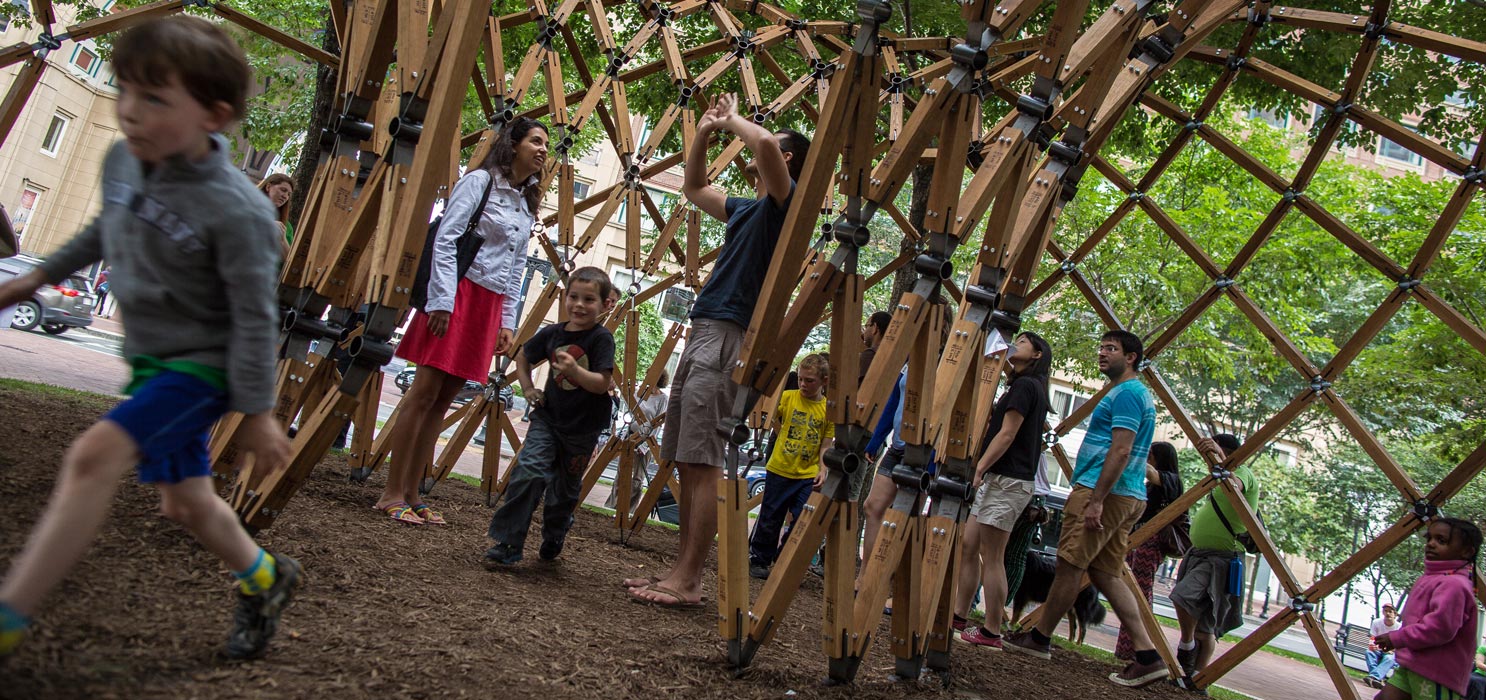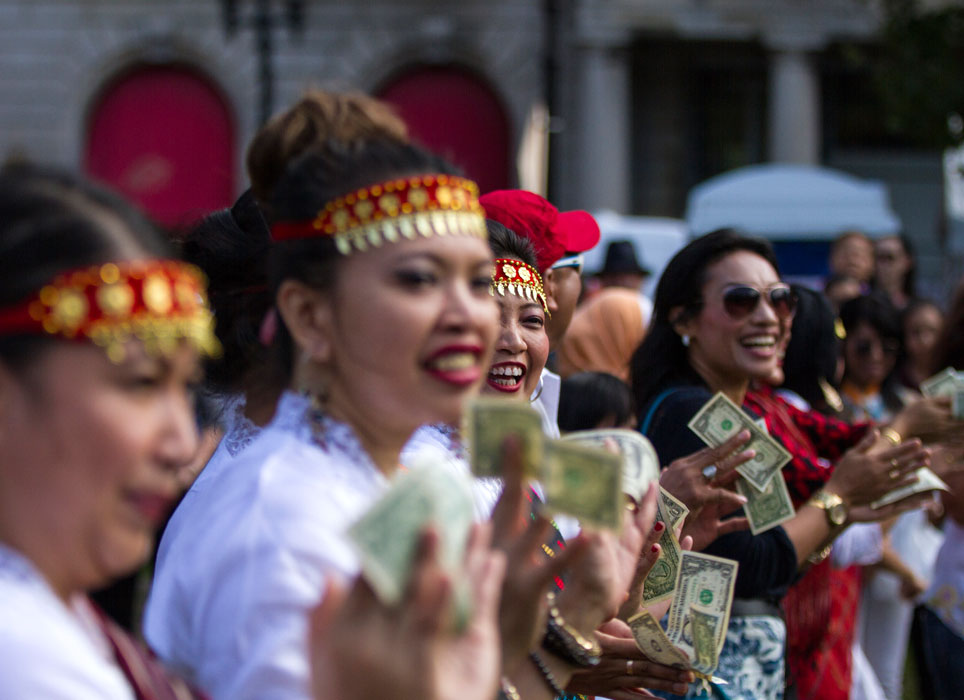Boston Foudnation Boston and Other American Cities Susatin Art
Boston has tremendous assets in arts and culture, including vibrant theaters, landmark historic architecture, compelling public art, and honour-winning artists and playwrights.
At the same fourth dimension, Bostonians who intendance about the future of arts and culture in their city understand that these face very substantial challenges. Still the urban center has the artistic potential—in its arts and culture sector, its public and private institutions, and every community and neighborhood in the city—to create what the Mayor has described as an "arts and culture renaissance" in Boston.
The planning process, research, and lived experience tell us that Boston'southward unique set of challenges and opportunities eye effectually infrastructure, equity and inclusion, and leadership and resources. Merely a larger change needs to take identify before we can brainstorm to make progress in those 3 areas. Nosotros need a culture shift in how we collectively value and resources arts, culture, and creativity in Boston.
Examining each of these areas below —infrastructure, equity and inclusion, leadership and resources, and the need for a culture shift— helps us understand the country of arts and culture in Boston today equally the foundation for how nosotros move forward, guided by the cultural plan.
Infrastructure
Supporting arts and civilisation and creative life requires infrastructure: work, operation, and exhibition space; educational institutions and programs; arts service organizations; artists' housing; private and public arts funders; and government entities to provide supportive policies, regulations, and resources. Boston has both great strengths and significant deficits in the necessary infrastructure to sustain arts and civilisation.
From an overall perspective, Boston has a remarkably vibrant and varied arts and civilisation sector that reaches securely into private lives, neighborhoods, and communities. It is dwelling house to more than than 1,500 nonprofit arts and culture organizations, giving it i of the highest per capita concentrations of such groups amidst major American metropolitan areas. From renowned anchor institutions with many layers of programs and activities, to small organizations often serving specific neighborhoods and communities, these organizations play a primal role in Boston'south artistic life.
Boston is also a identify where arts education thrives. Artists come up to acquire and train in the city's prominent art and music schools. Our valuing of arts instruction as a fundamental component of public didactics is clearly evident in two examples: the Boston Arts Academy—a high school within the Boston Public Schools (BPS), co-founded by a consortium of art schools and colleges—which has received both national and international awards for excellence; and BPS Arts Expansion, a program that has gained national recognition for its success in increasing quality arts educational activity in schools across the district.
Despite such strengths, the Boston Creates community date process establish a stiff consensus that Boston's infrastructure for arts and civilisation seems deficient in primal respects. Critical issues include:
- a need for new affordable cultural spaces and facilities, and difficulties in meeting the costs of and maintaining existing spaces and facilities;
- an acute and increasing lack of affordable housing and workspace for Boston artists;
- significant imbalances and gaps in funding for Boston artists and arts and civilization organizations.
These factors make themselves felt in very concrete ways. Although many artists come to Boston for education and training, and oftentimes get their professional start here, they lack many support structures and resources that they demand for successful careers—and that exist in several peer cities. As a consequence, some artists are leaving Boston. Arts and culture organizations are likewise facing uncertainty as they strive to place themselves within a rapidly changing existent estate landscape. Some struggle to back up critical ongoing maintenance needs for their facilities.
One overarching weakness in the infrastructure of Boston's arts and culture sector threatens the city's ability to respond effectively to the needs of that sector: silos. Artists, arts organization leaders, arts funders, and customs leaders run across neighborhoods, artistic disciplines, and various fundamental participants—including Urban center departments and offices—as isolated from one another and rarely, if ever, interacting, let alone collaborating. This fragmentation and isolation hinder, amidst other things, the relationship between arts and civilization and such allied sectors as pattern, tourism, and commercial arts. Too many people whose joint efforts could strengthen the infrastructure for arts and civilization in Boston say that they have never been in a room together.
This fragmentation has been pervasive in the Boston arts and culture world. The city at present has a tremendous opportunity to start bringing people together across such barriers and fostering relationships that have never existed before.
Equity and inclusion
In Boston Creates' community engagement process, Bostonians spoke loud and clear nigh a lack of both the disinterestedness and inclusiveness that a city with Boston'south variety, and diverse arts and cultural assets, needs to accept. While many Bostonians feel immense pride in, and connexion to, their cultural heritage, they very ofttimes do not see their communities or creative traditions represented or supported in the larger mural. Particularly among the metropolis's communities of color, residents study difficulty in accessing Boston's arts and culture riches. Youth, especially, are unsure at which institutions they are welcome, or in which creative settings (e.yard., community centers, galleries, libraries) they are meant to be included. Many feel that certain cultural venues and events in the city are "non for them."
Issues of equity and inclusion also have geographic implications: arts and civilisation organizations outside of downtown are likely to be small and underfunded. Boston residents need and want access to arts and culture opportunities close to abode, just such opportunities, and the resources that brand them possible, are unevenly distributed across the city.
Boston has the good fortune to have arts and culture institutions—some known around the country and the world—that bring students and visitors into the city. Huntington Avenue, Boston's "Avenue of the Arts," is home to numerous cultural institutions that contribute enormously to raising Boston'south contour every bit an arts heart. Valuable as these prestigious institutions are, however, they practise not begin to comprehend the total spectrum of arts and civilisation in Boston. The neighborhoods that lie across the well-known arts areas are filled with artists, arts and civilisation organizations, programs, and events—nonetheless almost visitors to Boston (likewise every bit many who alive or work in the urban center) know nada about the arts and culture activity there. This speaks to a failure by the city every bit a whole to recognize, value, and promote all communities and cultural expressions equally.
Arts and civilisation not only enrich our individual lives only have enormous potential to strengthen bonds of customs across a city and promote civic creativity and collective capacity. They have a unique ability to foster pride within individual communities, support understanding and respect between unlike communities, and span differences across the city. This means that equity and inclusion in arts and civilisation—the equal valuing of all cultural traditions and expressions, and equal access for all to arts and civilization action—are not but a matter of justice. They are also a necessity for creating a thriving, salubrious, and innovative metropolis for everyone, regardless of racial or socioeconomic background. An arts and culture sector without equity and inclusion reinforces divides built on entrenched racism and exclusion, preventing us from drawing upon the creativity of all Bostonians to fashion a amend civic futurity.
Leadership and resources
Strengthening Boston'southward arts and civilization infrastructure past addressing critical needs and forging interconnections, making this crucial sector of the city more equitable and inclusive—this requires leadership.
The Boston Creates planning procedure represents an important first step toward a much more active office for municipal government in arts and civilization than Boston has seen in decades. Many leaders in Boston's arts and civilisation, philanthropic, educational, wellness, and corporate sectors accept joined the Mayor past serving on Boston Creates' Leadership Council and Steering Committee. The chairs of the community teams take played a vital part by representing residents of every neighborhood in the city, which has farther empowered them equally cultural leaders within their respective communities.
For some of the tasks set out in this cultural plan it is, and volition be, indispensable to have leadership from the summit. Metropolis government, with its legal authority and convening ability, has a major function to play, equally practise Boston's leading private institutions in the corporate, philanthropic, and educational sectors likewise every bit in the arts and culture sector itself. At a moment of new leadership for the City and for many of these private institutions, the City has an opportunity, which we are now seizing, to set a new course and dedicate new efforts to making Boston a truly great city for arts, culture, and creativity.
All the same not all of the necessary leadership should, or fifty-fifty can, come up from the elevation or from citywide institutions. Every bit the Boston Creates planning process has fabricated clear, Boston has strong arts and culture leadership at the community and neighborhood levels. For much of what Boston needs to do to strengthen its arts and culture sector, the City and prominent citywide institutions can spark or catalyze alter—but the leadership for it must come from the larger Boston customs.
The need for citywide leadership is especially evident given the need for resources for arts and civilisation in Boston. While the city'south arts and culture sector is notable for its committed private donor base, the principal beneficiaries of this back up tend to exist large organizations. Compared with other cities, Boston has limited foundation, corporate, and municipal support for the arts, especially for pocket-size and mid-sized organizations and individual artists.
[one] Come across The Boston Foundation, How Boston and Other American Cities Back up and Sustain the Arts: Funding for Cultural Nonprofits in Boston and 10 Other Metropolitan Centers (2015) (accessed June 3, 2016).
Need for a culture shift
When it comes to issues such as silos in Boston'due south arts and civilization earth, the need for greater equity and inclusion, or the style Boston has traditionally funded organizations in this sector, many of the greatest challenges practice non arise solely from the external environment. Although such pressures equally rapid development and economic factors are very real, some of the primary challenges facing the metropolis's arts and civilization sector come from outdated mindsets and approaches to the arts. Today'south various and dynamic Boston demands new ways of seeing and acting that corporeality to a culture shift in how we arroyo arts and culture.
For example, the fragmentation in Boston's arts and culture sector, described above, is in many cases more than a matter of habit and custom than the result of formal barriers. In a city where the past is e'er visible, the prestige of some of the larger, older arts and civilization institutions creates an impression, for some, that arts and culture in Boston is primarily the domain of these major players. It will take a alter in perspective, and so, for the city to begin valuing all of its arts and civilization institutions as.
Moreover, distinctions between formal and informal fine art, or fine art and folk art, are besides ofttimes a part of Boston's way of viewing arts and culture. Unfortunately they create and reinforce divisions across lines of race, ethnicity, class, and geography. Instead of maintaining these boundaries as if they were hard and fast, we should gloat and accept advantage of what the swell American author Ralph Ellison called "one of the nearly precious of American freedoms, which is our freedom to augment our personal civilization by arresting the cultures of others."
Finally, newcomers to Boston accept observed that our city—a earth-class generator of pathbreaking ideas, inventions, and enterprises—remains oddly hierarchical in where it looks for civic leadership, expecting it to come exclusively from certain major institutions.
At the aforementioned time, in that location has until recently been no expectation that City government and the metropolis'due south major foundations and corporations would support arts and culture the way that private patrons in Boston have long supported them. This makes Boston unlike other American cities, where arts and culture do good profoundly from coordinated public, corporate, and foundation support.
The good news is that nosotros tin change our attitudes and behavior and set new expectations. As a result of the Boston Creates cultural planning process, this change has already begun. Scores of participants in the process have noted how many valuable connections they made and collaborations they took part in while engaged in information technology. Boston Creates and the work of implementing the plan must keep to exist a platform for achieving collaboration and modify.
Source: https://www.boston.gov/departments/arts-and-culture/boston-creates-strengths-challenges-opportunities




0 Response to "Boston Foudnation Boston and Other American Cities Susatin Art"
Post a Comment